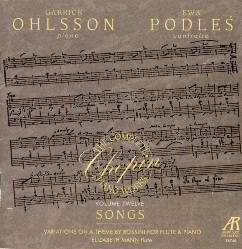Frederic Chopin - Songs (Ewa Podles) [2000]
Frederic Chopin - Songs (Ewa Podles) [2000]

1. The wish (wds. S. Witwicki: 1829) 2. Spring (wds. S. Witwicki: 1838) 3. The sad stream (wds. S. Witwicki: 1831) 4. Merrymaking (wds. S. Witwicki: 1830) 5. There where she loves (wds. S. Witwicki: 1829) 6. Out of my sight! (wds. A. Mickiewicz: 1829) 7. The envoy (wds. S. Witwicki: 1830) 8. Handsome lad (wds. B. Zaleski: 1841) 9. Melodya (wds. Z. Krasinski: 1847) 10. The warrior (wds. S. Witwicki: 1830) 11. The double end (wds. B. Zaleski: 1845) 12. My darling (wds. A. Mickiewicz: 1837) 13. I want what I have not (wds. B. Zaleski: 1845) 14. The ring (wds. S. Witwicki: 1836) 15. The bridegroom (wds. S. Witwicki: 1831) 16. Lithuanian song (wds. S. Witwicki: 1831) 17. Hymn from the tomb (wds. W. Pol: 1836) 18. Charms (wds. B. Zaleski: 1830) 19. Reverie (wds. B. Zaleski: 1840) 20. Variations in E Major for Flute and Piano Ewa Podles – contralto Garrick Ohlsson – piano Elizabeth Mann - flute
It doesn't matter what voice range Chopin originally scored his 19 songs for. They've been performed by mezzo-sopranos, sopranos, and sometimes with just a lone piano. It was a stroke of genius for Arabesque to have enlisted contralto Ewa Podles. Good contraltos occur rarely, even more rarely than their male equivalent, the countertenor. Not since Kathleen Ferrier has a contralto mined such quarries of feeling. Her rendition of "Nie Ma Czego grzeba" (Faded and Vanished) is so melancholic, so early Romantic, that it could have been penned by Franz Schubert. The melismas at the end of each stanza can extract tears. Her rendition of "Out of My Sight" dramatically conveys the conflicting emotions of one lover parting from another. Elly Ameling and Dietrich Fischer-Dieskau sing Schubert lieder with similar finesse, pacing, and eloquence. It's too bad Chopin didn't write more of these songs. They transcend the forms in which he fit them. They are morose ("The Two-Fold End"), raucous ("Drinking Song"), martial ("The Warrior"), even slightly earthy ("Lithuanian Song").
Pianist Garrick Ohlsson, who has performed in the previous 11 volumes, proves an excellent accompanist. His technique is sensitive, well-paced, and flamboyant only when required, never showy. Like pianist Gerald Moore, he never draws attention from the vocal pyrotechnics of his singer.
The final piece, Variations in E major for flute and piano (for "Non piu mesta" from Rossini's La cenerentola), was composed when Chopin was 14. Although a bit anticlimactic after these marvelous songs, the piece shows that Chopin, while not a child prodigy like Mozart or Mendelssohn, was on the way to greatness. Flutist Elizabeth Mann and Ohlsson render the piece well. Compulsive Chopin collectors will be happy to have it. ---Peter Bates, Rovi
download: uploaded anonfiles mega 4shared mixturecloud yandex mediafire solidfiles
Last Updated (Sunday, 06 October 2013 17:33)








